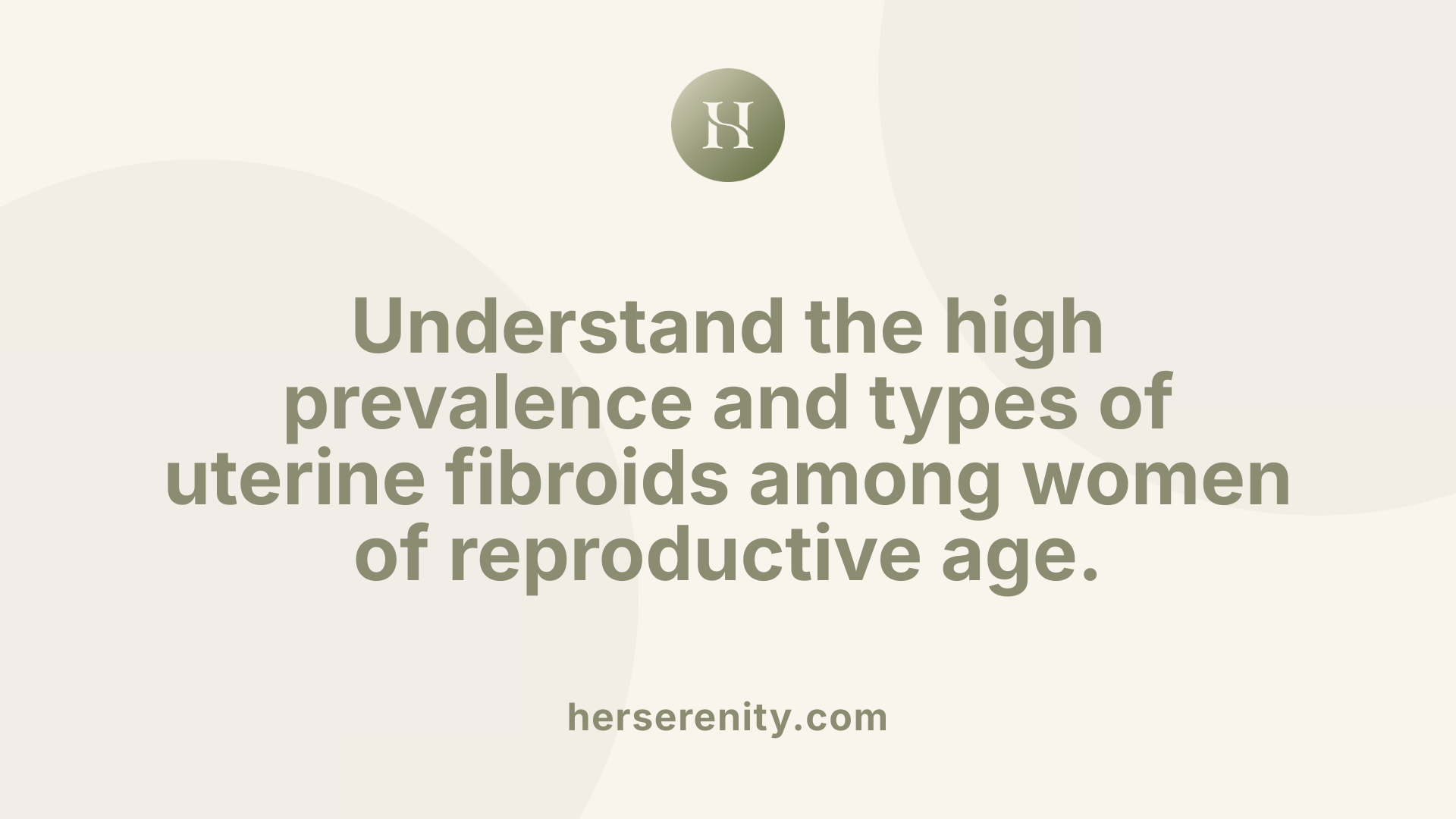Understanding Uterine Fibroids and Fertility
Uterine fibroids, benign tumors affecting a significant portion of women of reproductive age, present a complex challenge in reproductive medicine. Their presence can impact fertility outcomes by altering the uterine environment and complicating pregnancy. This article explores the ways uterine fibroids affect fertility, the treatment options available, and how medical interventions may assist individuals and couples striving to conceive.
Prevalence and Characteristics of Uterine Fibroids

What are uterine fibroids and how common are they among women of reproductive age?
Uterine fibroids, medically termed leiomyomas, are benign tumors composed of smooth muscle tissue that develop within or on the uterus. These growths can vary widely in size, number, and location within the uterine structure. They are categorized by their position relative to the uterine wall:
- Submucosal fibroids: Located just beneath the uterine lining, growing into the uterine cavity.
- Intramural fibroids: Found within the muscular wall of the uterus.
- Subserosal fibroids: Projecting from the outer uterine surface.
- Pedunculated fibroids: Attached to the uterus by a stalk.
The prevalence of fibroids is significant among women of reproductive age, affecting approximately 35-77% depending on the demographic and diagnostic criteria. The likelihood of fibroid presence increases with age, reaching 70-80% in women approaching menopause, around age 50.
Ethnic background also influences fibroid prevalence. African American women show a higher incidence and often develop fibroids at a younger age compared to women of other ethnicities. Additionally, risk factors such as genetics, hormonal levels, and obesity contribute to the variation in fibroid growth and detection rates.
Understanding the types and high prevalence of uterine fibroids is critical for assessing their potential impact on reproductive health and tailoring appropriate treatment options.
How Uterine Fibroids Affect Fertility
How do uterine fibroids impact fertility outcomes?
Uterine fibroids can negatively influence fertility through several interconnected mechanisms. They often impair the reproductive process by physically obstructing the fallopian tubes, which hinders the normal transport of gametes (sperm and egg). This mechanical blockage can reduce the chances of fertilization.
Mechanisms by which fibroids impair fertility
Fibroids may cause distortion of the uterine cavity, especially when they are submucosal or large intramural types that bulge inward. This alteration in the normal uterine architecture can interfere with the environment necessary for embryo implantation. Changes include abnormal uterine contractility, altered cytokine profiles, irregular vascularization, and chronic inflammation.
Impact on fallopian tube function and uterine cavity
When fibroids are positioned near or within the uterine cavity, they may affect the fallopian tubes by restricting their patency or disrupting the passage of eggs and sperm. The distortion of the cavity also directly limits the available surface area for embryo attachment and can lead to an inhospitable environment for embryo development.
Influence on endometrial receptivity and embryo implantation
Fibroids negatively influence the endometrial lining's receptivity by altering the hormonal milieu and reducing blood flow. This environment is crucial for establishing successful implantation. Submucosal fibroids, in particular, are linked with significantly reduced pregnancy and implantation rates, with relative risks of approximately 0.3 for pregnancy in affected women. Intramural fibroids have a moderate impact, reducing implantation risk but less severely than submucosal types.
In summary, fibroids contribute to infertility by obstructing tubes, reshaping the uterine cavity, and impairing the hormonal and vascular conditions necessary for implantation, leading to decreased fertility and increased risk of early pregnancy loss.
Fibroid Location and its Specific Effects on Fertility

What are the differences between submucosal, intramural, and subserosal fibroids?
Uterine fibroids are classified by their location relative to the layers of the uterus. Submucosal fibroids grow just beneath the lining of the uterine cavity and can protrude into the cavity itself. Intramural fibroids develop within the muscular wall of the uterus. Subserosal fibroids form on the outer surface of the uterus, often growing outward.
How does the location of uterine fibroids influence fertility and ART outcomes?
The location of fibroids greatly influences their impact on fertility and outcomes of assisted reproductive technologies (ART). Submucosal fibroids are the most detrimental to fertility. They distort the uterine cavity, impair embryo implantation, and lower pregnancy rates with a relative risk of about 0.3 for pregnancy and implantation, especially in ART. Removing these fibroids usually improves pregnancy outcomes.
Intramural fibroids have a variable effect. Smaller ones may have little impact, but fibroids larger than 5 cm and those affecting the uterine cavity shape can reduce implantation success. The relative risk for implantation associated with intramural fibroids is approximately 0.62. Surgical removal is often considered when fertility is affected.
Subserosal fibroids generally do not interfere with fertility or ART results. They grow outward from the uterus and rarely affect the uterine cavity shape or embryo implantation. Removal of subserosal fibroids does not confer significant fertility benefits.
What are the relative risks associated with fibroid locations during assisted reproductive technologies?
- Submucosal fibroids: Relative risk ~0.3 for pregnancy and implantation, markedly reducing ART success.
- Intramural fibroids: Relative risk ~0.62, showing a moderate reduction in implantation and pregnancy rates.
- Subserosal fibroids: No significant effect on ART outcomes; removal is typically unnecessary for fertility improvement.
Understanding the fibroid type and location is crucial in guiding treatment decisions aimed at optimizing fertility and reproductive outcomes.
Pregnancy Complications Associated with Fibroids
What pregnancy complications are associated with uterine fibroids?
Uterine fibroids during pregnancy can increase the risk of several complications.
Fibroids are linked to a higher chance of miscarriage and preterm labor, affecting the likelihood of a successful full-term pregnancy. They may also contribute to malpresentation, a condition where the fetus is positioned abnormally, which can complicate delivery.
In addition, fibroids increase the risk of placenta previa, where the placenta covers the cervix, potentially leading to severe bleeding. Postpartum hemorrhage, or excessive bleeding after childbirth, is also more likely in women with fibroids.
How does fibroid growth during pregnancy influence these risks?
Fibroids often grow rapidly during pregnancy due to hormonal changes, particularly elevated estrogen and progesterone levels. This accelerated growth can worsen symptoms and increase the chance of complications such as pain, miscarriage, and preterm labor.
Despite these risks, it is important to note that most pregnancies involving fibroids proceed without major issues. The degree of risk depends on factors like fibroid size, number, and location.
What are the rates of cesarean section and postpartum hemorrhage in women with fibroids?
Women with uterine fibroids have increased odds of requiring a cesarean section. Fibroids can obstruct the birth canal or cause abnormal fetal positioning, making vaginal delivery more difficult or dangerous.
Postpartum hemorrhage rates are also higher, largely due to impaired uterine contractions caused by fibroids, which can prevent the uterus from contracting effectively after delivery. These complications necessitate close monitoring by healthcare providers during pregnancy and delivery.
| Complication | Influence of Fibroids | Clinical Impact |
|---|---|---|
| Miscarriage | Increased risk due to distortion of uterine environment | Early pregnancy loss |
| Preterm Labor | Triggered by rapid fibroid growth and inflammation | Premature birth risks |
| Malpresentation | Fibroid location may deform uterus, affecting fetal position | Complicates vaginal delivery |
| Placenta Previa | Placental implantation near cervix influenced by fibroids | Severe bleeding risk |
| Cesarean Section | Increased frequency due to obstruction or malpresentation | Surgical delivery preferred |
| Postpartum Hemorrhage | Impaired uterine contraction after birth | Bleeding requiring medical intervention |
Diagnostic Approaches for Uterine Fibroids in Fertility Assessment
How are uterine fibroids diagnosed in the context of fertility evaluation?
The primary diagnostic tool for detecting uterine fibroids during fertility assessments is transvaginal ultrasonography. This imaging method provides clear visualization of the uterus, enabling identification of fibroid size, number, and location. Its accessibility and high effectiveness make it the first-line examination in evaluating fibroids that may impact fertility.
Use of ultrasonography and MRI
While ultrasonography suffices for most cases, Magnetic Resonance Imaging (MRI) is employed in more complex scenarios. MRI is especially useful when ultrasonography results are ambiguous or when multiple large fibroids are suspected. It delivers superior anatomical detail, helping to distinguish fibroid types—submucosal, intramural, or subserosal—and assesses the extent of uterine cavity distortion, essential for fertility counseling.
Criteria for fibrosis evaluation in fertility patients
Evaluation criteria include fibroid size, with larger fibroids (often those ≥5 cm) drawing closer scrutiny for potential surgical intervention. Fibroid location is crucial, as submucosal fibroids significantly reduce implantation potential, while intramural fibroids may also affect pregnancy outcomes depending on their size. Assessing distortion of the uterine cavity is vital since it influences implantation and pregnancy success.
Role of imaging in treatment planning
Imaging findings guide treatment strategies, particularly when fertility preservation is a priority. Detailed mapping of fibroids assists healthcare providers in selecting appropriate fertility-sparing treatments such as hysteroscopic myomectomy for submucosal fibroids or laparoscopic approaches for large intramural tumors. Furthermore, imaging helps exclude fibroids in regions unlikely to affect fertility, sparing patients unnecessary procedures.
Together, ultrasonography and MRI form a comprehensive diagnostic framework, allowing individualized, effective management of uterine fibroids in women seeking to conceive.
Treatment Options to Improve Fertility in Women with Fibroids

What Are the Common Medical Treatments Available to Assist Individuals and Couples with Conception?
Medical management for fibroids primarily aims to control symptoms rather than restore fertility. Common medications include progestins, oral contraceptives, nonsteroidal anti-inflammatory drugs (NSAIDs), tranexamic acid, gonadotropin-releasing hormone agonists (GnRHa), selective progesterone receptor modulators (SPRMs) like ulipristal acetate, and aromatase inhibitors. These therapies offer short-term relief of bleeding and pain but have limited proven benefit in improving fertility outcomes related to fibroids.
Surgical Options Including Myomectomy
Myomectomy is the preferred surgical treatment for women desiring future fertility, particularly when fibroids distort the uterine cavity or exceed 5 cm in size. It can be performed via hysteroscopic, laparoscopic, or open abdominal approaches, depending on fibroid type and location. Submucosal fibroids, which significantly reduce implantation and pregnancy rates, benefit most from surgical removal. Intramural fibroids larger than 5 cm may also warrant myomectomy due to their potential fertility impact. Pregnancy rates after myomectomy generally range from 50-60%, with improved outcomes compared to untreated fibroids.
Minimally Invasive Procedures and Their Fertility Outcomes
Less invasive options such as uterine artery embolization (UAE) and magnetic resonance-guided focused ultrasound (MRgFUS) have been utilized to treat fibroids. Although these methods effectively reduce fibroid size and symptoms, current evidence advises caution for women seeking pregnancy. UAE is associated with increased risks of miscarriage and obstetric complications, and thus, it is generally not recommended when fertility preservation is a priority. MRgFUS is promising but lacks sufficient data on reproductive safety. Therefore, myomectomy remains the gold standard surgical treatment for improving fertility.
In summary, while medical therapies help manage symptoms associated with fibroids, surgical removal—specifically myomectomy—is the most effective approach to enhance fertility, especially for submucosal and large intramural fibroids. Minimally invasive treatments show potential but require further study before being routinely recommended for women trying to conceive.
Myomectomy as the Gold Standard for Fertility Preservation

Types of Myomectomy
Myomectomy, the surgical removal of uterine fibroids, is tailored to fibroid size, location, and patient fertility desires. The main approaches include:
- Hysteroscopic Myomectomy: Ideal for submucosal fibroids protruding into the uterine cavity. This minimally invasive method improves implantation and pregnancy rates by restoring the endometrial cavity.
- Laparoscopic Myomectomy: Preferred for intramural or subserosal fibroids, allowing removal with smaller incisions, less blood loss, and quicker recovery.
- Abdominal (Open) Myomectomy: Reserved for very large or multiple fibroids where minimally invasive approaches are not feasible.
Impact on Pregnancy Rates and Live Births
Myomectomy leads to significant improvement in fertility outcomes. Pregnancy rates after surgery reach between 50-60%, especially when fibroids distort the uterine cavity, such as with submucosal or large intramural fibroids (≥5 cm). Removal of these fibroids reduces risks of implantation failure and miscarriage. Additionally, fertility improvements are well-documented post-hysteroscopic myomectomy for cavity-distorting fibroids, enhancing both clinical pregnancy and live birth rates.
Comparison with Alternative Treatments Like Uterine Artery Embolization (UAE)
While less invasive options like Uterine Artery Embolization (UAE) and Magnetic Resonance guided Focused Ultrasound (MRgFUS) have shown promise in fibroid reduction, their role in fertility preservation is limited. UAE is generally not recommended for women planning pregnancy due to increased miscarriage rates and obstetric complications post-procedure.
Compared to UAE, myomectomy offers higher pregnancy and live birth rates, with fewer complications. Thus, myomectomy remains the preferred treatment for women seeking to conceive after fibroid management.
How does myomectomy influence fertility outcomes compared to other treatments?
Myomectomy, across its surgical variations, improves fertility outcomes markedly by restoring uterine anatomy, enhancing implantation chances, and reducing pregnancy loss. This contrasts with treatments like UAE, which pose higher risks and lower live birth rates, making myomectomy the gold standard for fertility preservation in women with symptomatic fibroids affecting reproduction.
Role of Assisted Reproductive Technologies in Women with Fibroids
What role do assisted reproductive technologies play for women with uterine fibroids?
Assisted reproductive technologies (ART), such as in vitro fertilization (IVF), play a significant role for women with uterine fibroids seeking to conceive. Fibroids, especially those located submucosally, can drastically reduce implantation and pregnancy rates during ART. Studies show that the relative risk of pregnancy and implantation in women with submucosal fibroids drops to about 0.3 compared to those without fibroids.
How do fibroids affect IVF and implantation rates?
Submucosal fibroids distort the uterine cavity, impairing embryo implantation and thus decreasing pregnancy chances in ART cycles. Intramural fibroids have a milder impact, with a relative risk around 0.62 for implantation, while subserosal fibroids generally do not affect fertility or ART success.
What are the strategies to improve ART success in women with fibroids?
Removing submucosal fibroids before assisted reproductive procedures significantly enhances implantation and pregnancy rates. Surgical approaches like hysteroscopic myomectomy are preferred for resecting these fibroids due to effectiveness and uterine preservation. Management of intramural fibroids is more contentious; however, removal may be considered if fibroids are large (≥5 cm) or distort the cavity.
How is the decision made about fibroid removal before ART?
Decision-making incorporates fibroid size, number, and location along with symptomatology and fertility goals. Medical teams carefully assess whether fibroid resection can maximize ART outcomes without undue surgical risks. For submucosal fibroids, removal is generally recommended. For intramural fibroids, individualized evaluation directs the management plan, balancing potential benefits against surgical considerations.
These thoughtful interventions aim to optimize fertility outcomes for women with fibroids undergoing assisted reproductive technologies.
Impact of Fibroids on Fertility Treatment Success Rates

How do fibroid characteristics influence treatment efficacy?
Fibroid features such as size, number, and location critically shape the success of fertility treatments. Submucosal fibroids, which protrude into the uterine cavity, are strongly linked to reduced implantation and pregnancy rates. Removal of these fibroids often improves outcomes. Intramural fibroids, especially those larger than 5 cm, can also lower implantation success but to a lesser extent than submucosal fibroids. Conversely, subserosal fibroids located on the outer uterine wall generally do not impair fertility nor does their removal enhance treatment success.
What factors affect implantation and pregnancy success in women with fibroids?
Fibroids may obstruct fallopian tubes or distort the endometrial cavity, interfering with embryo implantation. These tumors can alter uterine contractility, cytokine profiles, and vascularization—all vital for a receptive endometrium. Additionally, larger and multiple fibroids exacerbate these effects. Assisted reproductive technologies (ART) outcomes show significantly lower pregnancy and implantation rates with submucosal fibroids, with relative risk as low as 0.3. Intramural fibroids decrease ART success more moderately.
How do lifestyle and biological considerations contribute?
Beyond fibroid pathology, patient-related factors influence fertility treatment success. Advanced maternal age, reduced sperm or embryo quality, and variations in uterine receptivity can impede outcomes. Lifestyle behaviors including smoking and obesity may also diminish fertility potentials. Optimizing these factors, alongside appropriate fibroid management, is essential for improving conception chances.
| Factor | Impact on Fertility Treatment | Notes |
|---|---|---|
| Fibroid Location | High (submucosal), moderate (intramural), low (subserosal) | Location dictates treatment approach and prognosis |
| Fibroid Size | Larger fibroids (>5 cm) present greater challenges | Size impacts cavity distortion and uterine function |
| Number of Fibroids | Multiple fibroids worsen uterine environment | Increases complexity of management |
| Patient Age | Advancing age lowers success rates | Age-related ovarian reserve decline |
| Uterine Receptivity | Critical for implantation success | Influenced by fibroid effects and hormonal status |
| Lifestyle Factors | Smoking, obesity reduce fertility outcomes | Modifiable contributors to treatment success |
| Treatment Methodology | Surgery (myomectomy) preferred for fertility preservation | Minimally invasive and medical treatments vary in efficacy |
Optimizing Fertility Care for Women with Uterine Fibroids
What reproductive health services are typically offered to support conception?
Women with uterine fibroids aiming to conceive receive a range of supportive reproductive health services. These often begin with comprehensive diagnostic assessments including transvaginal ultrasound and hormone testing to evaluate ovulatory function and fibroid characteristics. Imaging is essential to identify fibroid size, location, and potential impact on fertility.
Medical management may include hormonal treatments to regulate cycles or manage symptoms concurrent with fertility preservation. Assisted reproductive technologies (ART), such as in vitro fertilization (IVF) and intrauterine insemination (IUI), are commonly employed when fibroids affect fertility. For some patients, donor gametes or surrogacy may be considered, depending on individual circumstances.
How are fertility assessments and treatments coordinated?
Collaborative care involves fertility specialists, gynecologists, and sometimes reproductive surgeons working together. Personalized treatment plans are crafted based on the fibroids' characteristics and patients' reproductive goals. Surgical options like myomectomy may be recommended for fibroids that distort the uterine cavity or impair implantation, improving chances of pregnancy.
Minimally invasive techniques are preferred when possible to enhance recovery and preserve uterine integrity. Throughout the process, regular monitoring using imaging guides treatment decisions and tracks fibroid response.
What emotional and supportive care is available for affected individuals and couples?
Given the physical and emotional challenges posed by fibroids and fertility struggles, supportive care is integral. Counseling services assist patients and partners in coping with stress, anxiety, and uncertainty related to reproductive outcomes.
Fertility centers frequently offer educational resources and support groups aimed at fostering understanding and resilience. Open communication between healthcare providers and patients ensures concerns are addressed compassionately, supporting emotional well-being alongside medical care.
| Aspect | Description | Importance |
|---|---|---|
| Diagnostic Evaluations | Imaging (ultrasound, MRI), hormone testing to assess fibroid impact and ovulation status | Identifies factors affecting fertility and guides treatment |
| Medical Management | Hormonal therapies and symptom control | Supports cycle regulation and symptom improvement |
| Assisted Reproduction | IVF, IUI, donor gametes, surrogacy | Enhances chances of conception when fibroids impede natural fertility |
| Surgical Interventions | Myomectomy (hysteroscopic, laparoscopic) to remove fibroids affecting uterine cavity | Improves implantation rates and pregnancy outcomes |
| Collaborative Care | Multidisciplinary approach among fertility specialists and surgeons | Ensures comprehensive personalized treatment |
| Emotional Support | Counseling, education, support groups | Addresses psychological impact and enhances coping mechanisms |
Navigating Fibroids in the Journey Toward Parenthood
While uterine fibroids present challenges to fertility and pregnancy, advances in diagnosis and treatment allow many women to achieve successful conception and healthy pregnancies. Understanding the influence of fibroid location and size, along with individualized intervention strategies—especially myomectomy—can optimize fertility outcomes. Collaborative care in specialized fertility centers ensures that therapeutic decisions align with patients' reproductive goals, offering hope and support throughout their family-building journey.
References
- The Impact and Management of Fibroids for Fertility
- Uterine Fibroids and Infertility - PMC
- Can I have a baby if I have fibroids?
- The Impact of Uterine Fibroids on Reproductive Health and ...
- Fibroids and Fertility patient education fact sheet
- Understanding Fibroids and Fertility
- Removal of myomas in asymptomatic patients to improve ...





